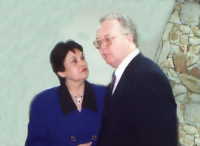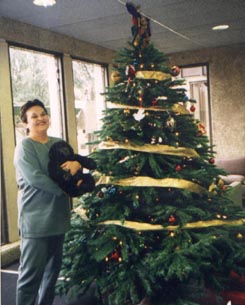São Paulo. Kendall had
decided to stay with his job at
American
Airlines. With family on two continents, the ease and cost of travel
the company provided employees were godsends. All in all, the
family had settled into a frugal but conformtable routine.
Many factors influenced
Kendall's decision to move back to the states, but one of the most important
were his aging parents (82 and 89). They were fast approchaing the time when
they would no longer be able to take care of themselves, and with no brothers
or sisters Kendell felt strongly the responsibility to take care of
them. When his father, Howard, fell and broke his hip in June of that year
and began an extended hospital stay and Kendall was forced to spend most of his
time on his parents' affairs it was an anticipated life event. We did not
view it as the tragedy we later understand it
foreshadowed.
The Diagnosis
That larger tragedy,the one that has ruled
our lives ever since, began in April of the next year, 1995, when I noticed a
lingering cough. My gynocologist diagnosed it as pneumonia and prescribed
an antibiotic. When the cough didn't improve and and a fleshy spot
developed on the right side of my back, I went to our family doctor, Dr. John
Wood. He immediately ordered an x-ray that revealed a suspicious-looking
mass in the lower lobe of my right lung. The x-ray was followed by a CT
scan, and on May 23th Dr. Wood told us there is a high probability of lung
cancer. He scheduled an appointment with a pulmonary specialist, Dr. Pedro
Paes, who set up a bronoscopy (inserting a tube through the nose to collect
material from the lung for a biopsy). The bronoscopy failed, and I was
scheduled for a medistinoscopy in which the sugeon would open a small slit in
my throat and insert a catheter to collect material from the mediastinium, or
the area of the between the lungs. Depending on the results, this would
be followed by surgery. This procedure was scheduled for July 3, 1995,
with Dr. Ogden as surgeon.
The results confirmed our
worst fears. Not only was the mediastinal fluid positive, meaning cancer
was present, but when he opend my lung the cancer had already spread.
This made a resection of the main tumor useless: they just closed me back
up. Kendall told me how Dr. Ogden sat with him after the surgery and just
shook his head and said, "It's really bad." He gave me six to eighteen
months to live, though Kendall didn't tell me that until after I had gotten
through those eighteen months.
I met Dr. Jivesh Sharma while still
convalescing in the hospital, and after I was released two weeks we made our
first office visit with him and radiologist, Dr. Gilbert, at the Richardson
Cancer Clinic. I have come to respect Dr. Sharma very much over the
ensuing years, both his skill and strong empathy with patients, but on that
visit he was uncompromising: "There is no
cure," he said. New treatment protocols could extend my
life
|
by as much as five years after
diagnosis. The goal of cancer treatment is no longer to cure, but to extend a
high quality life. He and Dr. Gilbert recomended starting with radiadion
and light chemotherapy. When I had all the radiation my body could absorb
I would switch to a more agressive combination of Taxol plus Carboplatin.
Of course, they would closely moniter my progress. |

São Paulo
August, 1995 |

Rony and Claudia
August,
1995
|
Claudia's
Wedding
But first Claudia
was about to get married and I insisted no plans be changed: I would start
chemotherapy after her
wedding. So it was that in August of 1995 all of us--me, Kendall, Raquel
and Christopher--went to São Paulo for Claudia and Rony's wedding.
The wedding was everything we could have hoped for, but I also began to feel
the first social effects of cancer, for my sisters insisted on following
the tradition from my home town of Cuiabá to not tell loved ones about terminal illnesses and decided
not to tell my parents. This gave me the added burden and stress of
keeping my terror silent in front of my mother and father who were, of course,
at the wedding. |
First Round Chemotherapy and Radiation
I started radiation and chemotherapy
as soon as we got back from the wedding. The library staff at work was
very supportive at this stage--as long as they thought my work wasn't
affected. During the first weeks while I was doing radiation and my
chemotherapy doses were still low, I would drive the couple of blocks to the
clinic during my lunch hour for the radiation treatment. For the
chemotherapy sessions that sometimes lasted most of the day I took a sick
day. This was about the time when the government began requiring
companies to give leave time for employees to take care of family memebers so
Kendall was able to take the time off from work to drive me there.
|
The treatments
were not as bad as I expected at first; my hair didn't fall out and, other
than the time I took for treatments, my work and home routines were little
affected. The initial shock of discovering I had cancer wore off and the
family began to experience some hope and guarded optimism. About half way
through the treatments though that began to change.
By November I fininshed the radiation portion
of my treatment and Dr. Sharma increased the dosage of Taxol, my primary
chemotherapy agent, adding Carboplatin, another powerful agent, to the
mix. The higher levels of chemo soon began to leave their characteristic
effects: I fainted one day at work and was put on Neupogen, and later blood
tansfusions, to build up my white blood count; and I began losing my
hair. The dietary supplement ENSURE was prescribed to
counter |

Christmas 1995, Richardson Public
Library |
the debilitating
effects of chemotherapy and it made me swell up like a balloom. I
threatened to stop, but Dr. Sharma insisted I should put on some fat now
because I would need the stored up energy later. Perhaps he was right,
but I have never again gotten back to my normal size.
The Catch-22 world of the
cancer patient began to catch up with us. The more intensive chemo caused
my hair to fall out, and although Dr. Sharma prescribed a prosthesis the
insurance, would not pay for it; it was not medically necessary (and it cost
over $500!). I had to keep working, of course, and it would have been
impossible to do that in the Children's Department of the library that isn't a
insurance considertion.
The other burden of
chemotherapy is constant nausea. There is an effective medicine for
nausea, Zofran,
but doctors don't like to
prescribe and insurance companies don't like to pay for because of its high
cost: around $20 a pill, and a patient suffering from nausea would take one
every eight hours. Dr. Sharma did not prescribe it at first, but as my
nausea grew worse he didn't hesitate.
Live after Chemo; learning to live with
Cancer
In February of 1996 I had
completed the regulation six infusion cycles of Taxol/Carboplatin and Dr.
Sharma recommended we stop. It was not what I was prepared to to
hear. A cancer patient comes to look on chemotherapy as a "friend:" the
oncology nurses and your family fuss over you and make you the center of
attention, but more important the chemo is your security. It
protects you from the disease that is trying to eat your insides out and
nourishes your fighting spirit--your psychological need to do
something. I was not ready to stop. The doctor agreeded to continue,
so on March 4th, 1996, I took what was to be my last infusion. It was a
decision the doctor allowed me to make after a lot of input.
It's
in my Head!
Gamma
Knife Surgery and Whole Brain Radiation
Things
Start to Fall Apart
The Long
Slide Downhill
Waiting for
the End
|